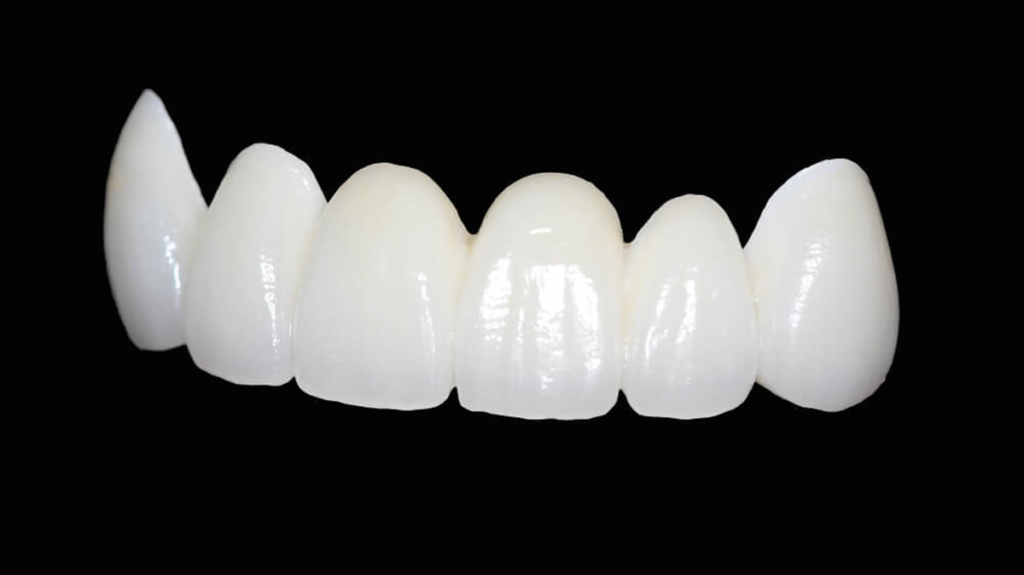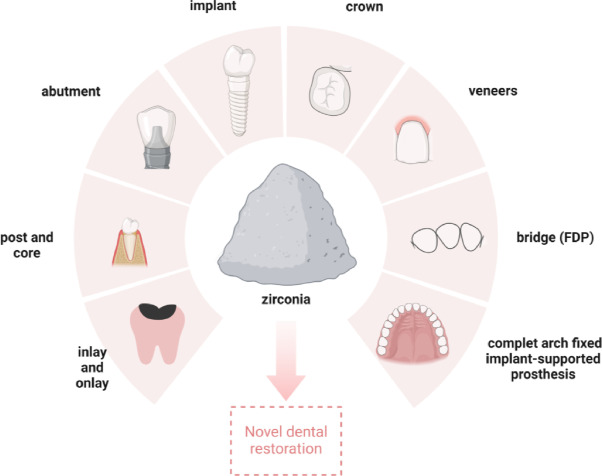Dental zirconia material has been propelled to the forefront of dental restoration materials due to its exceptional properties. This is further evidenced by zirconia dioxide’s successful 15-year clinical history in dentistry. It has replaced conventional metal-based restorations. Among its remarkable properties are high strength, wear resistance, translucency, biocompatibility, and radiopacity. It is used in zirconia dental implants, veneers, crowns, bridges, inlays, and onlays.

Types of Zirconia Material for Dental Restorations
Different types of dental materials are designed to meet the specific needs of various restorations. For example, layered zirconia is typically used in restorations like full crowns and bridges. Aidite stands out among dental Zirconia Material manufacturers for providing cutting-edge dental zirconia material that combines strength, aesthetics, and efficiency. Aidite delivers products that cater to the diverse needs of modern dentistry.
3D Pro Zir
3D Pro Zir or 3D Pro Zir Zirconia Blocks is a high-performance dental zirconia material designed for dental restorations by Aidite. It offers both strength and natural aesthetics. From single crowns to full bridges it is suitable for a wide range of dental restorations. The material features a natural shade gradient that creates a lifelike appearance without visible layers.
Aizir
Aizir is an ideal choice for high-demand environments requiring speed and precision.
The material can be sintered at a range of temperatures. This flexibility helps it maintain both strength and translucency, regardless of the firing conditions. It can be used in single crowns
bridges, and implant-supported restorations.
Aizir Flash
AIZIR Flash Zirconia Material is designed for high-speed sintering without compromising strength or aesthetics. It is particularly suited for single-unit restorations and cases where quick turnaround is essential without sacrificing quality.
Benefits of Dental Zirconia Material
Dental zirconia material is a powerful and versatile material widely used in dental restorations due to its remarkable characteristics. It provides various advantages over other commonly used materials like metals, porcelain, etc. Here are some advantages of dental zirconia material:
- Strength
Zirconia exhibits a flexural strength of 900–1200 MPa. The strength of other materials, like nanoceramic and acrylic, is about 200–400 much lower MPa. Its strength makes it fracture-resistant.
- Biocompatibility
The material used in any medical procedure should be biocompatible. It should not produce any immune response in the human body. Several studies have proved that dental zirconia material does not cause any adverse reactions in the body.
- Translucency
Translucency means how much light can pass through teeth. While choosing materials for dental restorations it is important to consider translucency because it can affect functionality. Zirconia is ultra-translucent which balances both strength and esthetics.
- Wear resistance
Zirconia restorations, such as crowns, bridges, and inlays/onlays, are highly wear-resistant. Dental zirconia material is also low maintenance. Dental materials can wear down due to factors like food, saliva, pH, and bruxism.
- Durability
Zirconia dental restorations can last anywhere from 10 to 20 years. Proper oral care can also extend the life of dental zirconia restorations.
- Aesthetic Appeal
One of the excellent features of dental zirconia material is that it can match the color of
teeth. Due to high translucency, it can mimic the shine of natural tooth enamel.
Applications of Dental Zirconia Material
Dental Zirconia Material is widely used in orthodontics and aesthetics dentistry. Let’s have a detailed look at the applications of dental zirconia.

Zirconia dental crowns and bridges
Dental crowns and bridge restorations are popular techniques for covering tooth decay and discoloration. Commonly used materials for bridges and crowns include metals, ceramics, porcelains, and resin. Each material has its own advantages and disadvantages.
- Dental crown restoration is a process in which a custom-made cap (crown) is placed onto the decayed or fractured tooth. Dental crown material zirconia is best in terms of longevity and strength. It is safe from wear and tear.
- Dental bridge restoration involves placing a false tooth in place of the missing tooth. Bridges made of zirconia dental material are preferred to any other bridge because they are solid and best-looking.
Zirconia dental implants
Dental implantation is a surgical method for placing a lost tooth. For optimal results, it is crucial to consider the type of material used in the implant. Zirconia dental implant material is used in non-metallic dental implants. The biggest perk of zirconia dental implants is that they can match your natural tooth color.

Zirconia dental veneers
Veneers are shells placed onto the tooth to improve their appearance. They can conceal all the imperfections improving the aesthetics of teeth. Using zirconia for making dental veneers is extremely beneficial since zirconia is very strong. Other materials for veneers include porcelain. But if you clench or grind your teeth they may not be suitable for you.
Zirconia dental inlays and onlays
Inlays and onlays are restoration techniques for decayed or damaged teeth. These methods strengthen the tooth structure. Inlays are typically used for cavities in the back teeth. While onlays cover one or more cusps. Zirconia dental material is strong and fracture-resistant and it can withstand the biting forces without breaking or cracking.
CAD/CAM milled zirconia restorations
Computer-Aided Design (CAD) and Computer-Aided Manufacturing (CAM) and modern technologies for dental restoration. In Computer-Aided Design, software is used to take digital scans of patient’s teeth. After design, the restoration is milled using a computer-controlled machine. CAD/CAM technology with high-quality dental zirconia material can produce highly pleasing results.
FAQs related to Dental Zirconia Material
What are zirconia dental materials?
Dental zirconia material contains Zirconia Oxide which is found in nature. However, ZrO₂ is unstable. Yttria is added in it to make it stable for usage in dental restorations. Yttria-stabilized zirconia(Y-TZP) has many properties that make it superior to other dental materials.
Are zirconia dental implants safe?
Zirconia dental material has been studied in the lab for 15 years. Several studies have shown that it is safe for use in dental procedures. Zirconia dental implants are safe, biocompatible, and very strong.
What is a zirconia dental bridge?
A dental bridge is used to replace a lost tooth. These bridges are made up of different materials like metals, porcelain, ceramics, etc. A bridge in which dental zirconia material is used is called a zirconia dental bridge.
How much are zirconia dental implants?
As compared to other materials like titanium zirconia dental implants are expensive. They can cost somewhere in between $1500 to $7000.
Conclusion
Zirconia has revolutionized the dental restoration industry. It has an unmatched combination of properties like excellent strength, biocompatibility, translucency, wear resistance, durability, and aesthetic appeal. It can match the natural shade of teeth is resistant to wear in food, pH, and saliva, and can withstand strong chewing forces. It has a wide range of applications in dental crowns, veneers, implants, dental inlays, and onlays. Dental Zirconia Material integrated with CAD/CAM technologies can provide customized, reliable, and natural-looking restorations. Zirconia stands out as the leading choice compared to traditional materials like metal, porcelain, etc. Aidite is a brand trusted by professionals for top-tier dental zirconia material. They are unmatched in their durability, precision, and high-quality materials.



